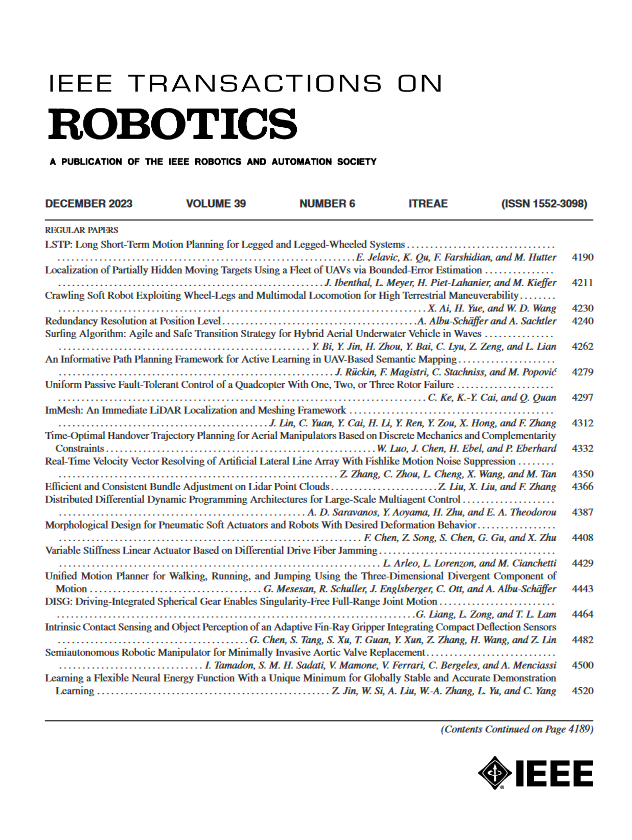Design, Modeling, and Experiment of a 3-DoF Miniature Plate Piezoelectric Robot
IF 10.5
1区 计算机科学
Q1 ROBOTICS
引用次数: 0
Abstract
The piezoelectric plate robot driven by traveling waves (TWs) boasts a compact structure and excellent load-bearing capacity. However, vibration coupling across the plate restricts its freedom of movement, along with issues, such as poor straight-line motion and a large turning radius. Inspired by octopus locomotion, we designed a three-degree-of-freedom (3-DoF) piezoelectric plate robot using a 0.7-mm metal plate. Through drive region division and dynamic modeling, our design achieves fully controllable motion in any planar direction, providing the highest DoF among TW-driven plate robots. Weighing just 14.2 g, it is lighter and easier to fabricate compared to other 3-DoF piezoelectric robots. The robot demonstrated 3-DoF movement capabilities, climbing (16.53-DoF微型板压电机器人的设计、建模与实验
由行波驱动的压电板机器人结构紧凑,承载能力优异。然而,板上的振动耦合限制了它的运动自由,以及诸如直线运动差和转弯半径大等问题。受章鱼运动的启发,我们使用0.7毫米的金属板设计了一个三自由度(3-DoF)压电板机器人。通过驱动区域划分和动力学建模,我们的设计实现了在任意平面方向上的完全可控运动,提供了tw驱动板机器人中最高的自由度。与其他三自由度压电机器人相比,它的重量仅为14.2克,更轻,更容易制造。该机器人展示了3-DoF运动能力,爬升(16.5$^\circ$),拖拽(20 g)和搬运(180 g),可以承受超过自身重量5000倍的重量。与开环控制相比,具有闭环控制的无线驱动器原型将轨迹误差降低了80%以上。涉及高曲率路径移动、受限空间“搜索和救援”以及光聚焦的实验突出了它在极端环境和高精度任务中的潜力。
本文章由计算机程序翻译,如有差异,请以英文原文为准。
求助全文
约1分钟内获得全文
求助全文
来源期刊

IEEE Transactions on Robotics
工程技术-机器人学
CiteScore
14.90
自引率
5.10%
发文量
259
审稿时长
6.0 months
期刊介绍:
The IEEE Transactions on Robotics (T-RO) is dedicated to publishing fundamental papers covering all facets of robotics, drawing on interdisciplinary approaches from computer science, control systems, electrical engineering, mathematics, mechanical engineering, and beyond. From industrial applications to service and personal assistants, surgical operations to space, underwater, and remote exploration, robots and intelligent machines play pivotal roles across various domains, including entertainment, safety, search and rescue, military applications, agriculture, and intelligent vehicles.
Special emphasis is placed on intelligent machines and systems designed for unstructured environments, where a significant portion of the environment remains unknown and beyond direct sensing or control.
 求助内容:
求助内容: 应助结果提醒方式:
应助结果提醒方式:


